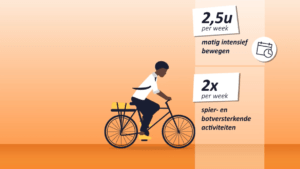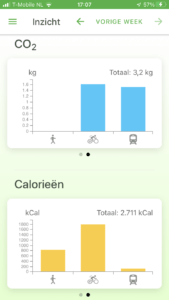Thrivey keeps track of the calories you burn during your daily travels. You might not be aware of it, but while travelling you burn quite a few calories. Different means of transportation will result in slightly different levels of calorie expenditure. In this blog we are going to explain what your calorie expenditure is for each mode of transportation and how Thrivey calculates this for you. We will also explain the varying results which arise with different means of transportation. At the end of the blog, we will indicate in kilocalories how much the Dutch Knowledge Centre for Sports and Exercise prescribes you should be exercising.
The MET (Metabolic Equivalent of Task)
The Metabolic Equivalent of Task or MET takes a central place in the calculation of calorie expenditure. The MET is a value that indicates how much energy it takes to perform a certain activity. The MET value tells us how many kilocalories a person burns per kilogram of body weight when that person carries out an activity for the duration of 1 hour. For example: Sleep has a MET value of 0.95, and the average adult weighs 78.5 kg (2). Therefore, after 8 hours of sleep, the average adult will have burned 0.95 (MET) x 78.5 (weight) x 8 (hours) = 597 kilocalories.
The corresponding formula for this goes as follows:
The number of calories burned = the MET value x weight in kilograms x duration of activity in hours.
The higher the MET value, the more demanding an activity is. Here are some examples of MET values, and the corresponding activities associated with those values.
| MET value | Description | Activity |
| 1 | Activity: none | Almost no body movement Example: sitting or lying down |
| 1 tot 3 | Activity: light | Ability to sing during the performance of this activity Example: leisurely walk, standing |
| 3 tot 6 | Activity: average | Ability to talk during the performance of this activity Example: a brisk walk |
| 6 tot 13 | Activity: strenuous | Ability to talk occasionally during the performance of this activity Example: jumping jacks or jogging |
| 15 | Expert level | Example: cycling at 36 km per hour |
| 23 | Professional | Example: running at 22 km per hour |
Something interesting to mention here is the example of a marathon runner. Eliud Kipchoge is the fastest human being in the world. He ran the marathon (42.195 km) in 2 hours, 1 minute and 39 seconds. The MET value for running a marathon is 19.8. When Eliud achieved his world record he weighed 52 kg. He burned 19.8(MET) x 52(weight) x 2.03(number of hours) = 2,087 kCal. A MET value of almost 20 is very high. But apparently, when you don’t weigh a lot, and you perform your activity for a relatively short time, the total calorie expenditure is -relatively- low. In comparison with, say, cycling a stage of the Tour de France we see that the cyclists burn somewhere between 6,000 and 8,000 kCal during a single stage. While the MET value of professional cycling is approximately equal to the MET value of running a marathon. And so, cyclists burn almost four times more kilocalories than a marathon runner because they weigh more, and they spend a longer time performing their activity.
Many studies have been carried out to properly calculate MET values. These studies have been collected in the Compendium of Physical Activities (1). For the calculations in Thrivey we have based the MET values for our various activities on the Compendium’s information as much as possible.
What is your calorie expenditure while travelling with different means of transportation?
At Thrivey, we make a distinction between motorized means of transportation and human-powered means of transportation. For motorized means of transportation the MET calculation is simple. The number of calories you burn while travelling isn’t influenced by the speed of the vehicle. For these means of transportation, we multiply the MET value of the specific means of transportation by the duration of the journey and the weight of the average Dutch person. (The average Dutch person currently weighs 78.5 kg). To give an example: Riding a motorcycle or a scooter is a reasonably strenuous activity. These vehicles have a MET of 2.8. Other motorized vehicles, such as a car or a train, in which you sit almost completely still most of the time have a MET of 1.3. So, if you travel by motorcycle, you will burn more calories compared to making the same journey by car.
There are means of transportation that are largely man-powered, like walking and cycling. Their MET values do differ from each other. Also, at varying speeds the MET values changes. To calculate the correct calorie expenditure, Thrivey divides your journey in different parts. For each part the number of calories you burn is calculated based on the speed and the time that part of your journey has taken. Finally, Thrivey combines all these calories of these parts and together they make up the total number of calories you have burned during one journey. There are no MET values in the Compendium of Physical Activities for road bikes, electric bikes, and speed pedelecs. For these means of transportation, we have made an estimate of their MET values at different speeds. We have taken in to account the following:
Cycling with an electric bike takes less energy than cycling on a normal bicycle at any speeds up to 25 km/hour. At speeds above 25 km/h the electric motor no longer gives support. Thus above 25 km/h, an electric bike is simply a heavy bike to cycle. This means that you burn more calories above 25 km/h with an e-bike than with a normal bike.
The motor of a speed pedelec supports the cyclist up to 45 km per hour. Above this value, the same story applies as with the electric bike.
A road bike takes less energy to ride than a regular bike, but it costs more energy to cycle with than an electric bicycle.
This is what the speed-MET graph looks like for these means of transportation:

The number of calories you burn with all these means of transportation remains an estimate, especially for your journeys by road bike, electric bike and speed pedelec. But even for means of transportation for which a standard MET value has been established, there are varying factors that can influence the outcome. For example, if you have a headwind, and you are travelling with some heavy luggage, your calorie expenditure will be higher than if you have a tailwind and you have no luggage with you. These are variables the app knows nothing about. Thrivey calculates the broad outline of your calorie expenditure during your travels.
What does all this mean, practically speaking?

In this blog we explained how Thrivey calculates the number of calories you burn during your daily travels. But what number of calories is a normal amount? How many calories should you be burning to call yourself healthy? The Knowledge Centre for Sport and Exercise in the Netherlands has an exercise guideline for these questions (3). They indicate that it is important for adults to engage in muscle and bone-strengthening activities at least twice a week. In addition, they recommend engaging in an activity of moderate intensity for at least 2.5 hours per week. A standard activity of moderate intensity has a maximum MET of 6. That means that you must burn 6 (MET) x 78.2 (weight) x 2.5 (hours) = +/- 1200 kCal, per week. If you cycle a total of 2.5 hours per week, then you’ve already reached this goal.

Looking at my own activities in the app, I can see that I have burned 2700 kCal last week, mainly by going out with my Speed Pedelec. I can see that the total amount was spread out during the week. I’m curious to see what my calorie expenditure will look like next week!
Sources:
- Ainsworth BE, Haskell WL, Herrmann SD, Meckes N, Bassett Jr DR, Tudor-Locke C, Greer JL, Vezina J, Whitt-Glover MC, Leon AS. (2011) Compendium of physical activities https://sites.google.com/site/compendiumofphysicalactivities/home
- Cyril Rosman(2019) Dutch people, taller and heavier https://www.ad.nl/binnenland/nederlanders-steeds-langer-en-steeds-zwaarder~a3f876511/
- Exercise guideline, by the Centre for Sports and Exercise. https://www.kenniscentrumsportenbewegen.nl/producten/beweegrichtlijnen/

